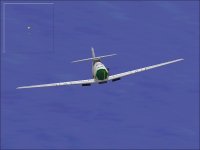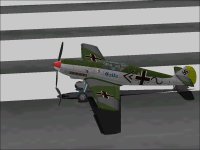The last several posts in "Fun Flying" about the Westland Lysander really should have been made here.
It is one of the reasons I find that I can't seem to finish up the longer running tasks.
Programming a new Gauge is a bit of tedious work and the way that I have things arranged, the task requires moving repeatedly between at least two computers. One is used for Internet access and to perform compiles of the actual .GAU file. The other is used to test the gauge in CFS. Even for a minor change, several steps are required.
The computer used to run the simulator has mostly been recovered but still lacks the graphics tools and compilers to do any serious development work. My laptop is reasonably powerful but really not suited for gaming.
I have quite a number of AFX project files on my Development Computer. Many of them are quite primitive but a few do have a very nice appearance but for a few "Little" problems. Those often look like good candidates for a very quick fix and a good dose of instant gratification. A couple years ago, the P-39D was one of those; A simple stretch of the nose gear looked like it would greatly improve the appearance. The Me 109E-Trop was also one of these projects that turned out to have much more wrong with it than it appeared. Recently the Lysander looked to be a pretty quick rework since all I was trying to fix was the dark canopy interior view.
The attraction of these projects is that they generally are in buildable condition already and the results of a fix can be seen in a minute or two. There is (at least to start) no need for tedious planning or laying out of pieces so they don't interact badly.
They don't require the 30-100 cycles of edit and test that are often necessary when tuning a flight model.
They seem much less like work than my normal projects.
Recently I thought that a repaint of the Me 109E-Trop would not be too difficult. It was pretty obvious that the textures to the Fuselage would need to be rearranged. I really didn't like the "Tropical" texture and had already "fixed" the Wings and Tail on my first encounter with this project.... or so I thought. It was also an opportunity to try out a texturing idea that had worked out extremely well with the Ki 61 in which a single large texture file was sliced into pieces and matched up on the model.
....The BIG difference as I found out was that the shapes of the Ki 61 are quite precise. Their dimensions are pulled from Japanese Model Art books with almost no guessing. A good profile fits almost perfectly.
The Me 109E on the other hand has numerous shape problems and pieces that are not the correct size or not where they are supposed to be and drawings don't match up all that well.
After a couple weeks of laying out new textures and switching between the Lysander and the Emil when one got to be too frustrating, I finally have a "reasonable" canvas. Since this is just a painting exercise, I haven't even started trying to fix the AIR file or DP file and may never get to those.
Here is where the Emil stands today. The little square patterns are where textures join and are to confirm that the mapping between files is consistent. This is one of those projects in which I would probably have felt better about the result if I had started from scratch.
- Ivan.
It is one of the reasons I find that I can't seem to finish up the longer running tasks.
Programming a new Gauge is a bit of tedious work and the way that I have things arranged, the task requires moving repeatedly between at least two computers. One is used for Internet access and to perform compiles of the actual .GAU file. The other is used to test the gauge in CFS. Even for a minor change, several steps are required.
The computer used to run the simulator has mostly been recovered but still lacks the graphics tools and compilers to do any serious development work. My laptop is reasonably powerful but really not suited for gaming.
I have quite a number of AFX project files on my Development Computer. Many of them are quite primitive but a few do have a very nice appearance but for a few "Little" problems. Those often look like good candidates for a very quick fix and a good dose of instant gratification. A couple years ago, the P-39D was one of those; A simple stretch of the nose gear looked like it would greatly improve the appearance. The Me 109E-Trop was also one of these projects that turned out to have much more wrong with it than it appeared. Recently the Lysander looked to be a pretty quick rework since all I was trying to fix was the dark canopy interior view.
The attraction of these projects is that they generally are in buildable condition already and the results of a fix can be seen in a minute or two. There is (at least to start) no need for tedious planning or laying out of pieces so they don't interact badly.
They don't require the 30-100 cycles of edit and test that are often necessary when tuning a flight model.
They seem much less like work than my normal projects.
Recently I thought that a repaint of the Me 109E-Trop would not be too difficult. It was pretty obvious that the textures to the Fuselage would need to be rearranged. I really didn't like the "Tropical" texture and had already "fixed" the Wings and Tail on my first encounter with this project.... or so I thought. It was also an opportunity to try out a texturing idea that had worked out extremely well with the Ki 61 in which a single large texture file was sliced into pieces and matched up on the model.
....The BIG difference as I found out was that the shapes of the Ki 61 are quite precise. Their dimensions are pulled from Japanese Model Art books with almost no guessing. A good profile fits almost perfectly.
The Me 109E on the other hand has numerous shape problems and pieces that are not the correct size or not where they are supposed to be and drawings don't match up all that well.
After a couple weeks of laying out new textures and switching between the Lysander and the Emil when one got to be too frustrating, I finally have a "reasonable" canvas. Since this is just a painting exercise, I haven't even started trying to fix the AIR file or DP file and may never get to those.
Here is where the Emil stands today. The little square patterns are where textures join and are to confirm that the mapping between files is consistent. This is one of those projects in which I would probably have felt better about the result if I had started from scratch.
- Ivan.















